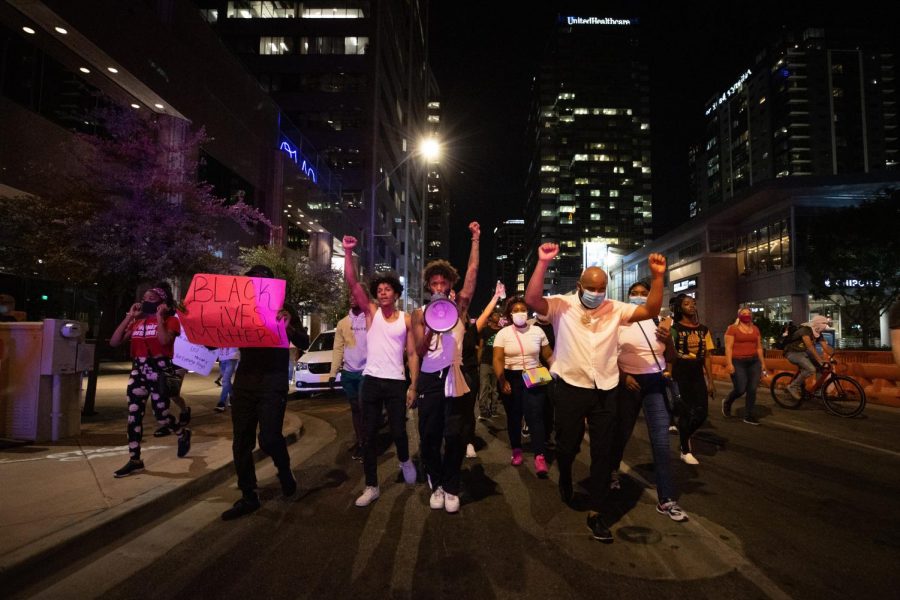Phoenix protesters being ‘hunted’ on Sunday were shown solidarity on Monday.
Photos taken at the Protest in Phoenix, Az.May 28 2020
June 2, 2020
Protesters were tear-gassed and shot at by Phoenix Police officers on Sunday after they declared a group of demonstrators was an unlawful assembly at 8:10 p.m., 10 minutes after the 8 p.m. curfew went into effect. That night, Phoenix P.D. arrested more than 200 protesters on “suspicion of rioting, unlawful assembly, disorderly conduct or curfew violations” according to an AZ Central article.
Sgt. Margaret Cox, a spokeswoman for the Phoenix Police Department said Phoenix Police declared an unlawful assembly “due to criminal activity,” as some protesters were reportedly lighting fireworks and throwing rocks and water bottles at police.
Some residents south of downtown Phoenix were witness to some of the interactions between police and protesters when the protest in downtown spilled over into Garfield neighborhood.
Elizabeth Lamay, her boyfriend and her two dogs were spending their night on their porch enjoying their night when police and protesters arrived on their street. In a video recorded by Lamay, she states to the police that she in fact lives at the residence while standing on the sidewalk in front of their front lawn. The police arrested both Lamay and her boyfriend for violating curfew.
According to the article made about this incident, an officer is heard in the video telling Lamay and her boyfriend: “You guys think you know. You think you know everything.”
Lamay was ultimately released without being cited but that statement was infuriating to her.
“There was no reason to treat somebody that way,” she said. “We were standing there. We weren’t running at them.”
Another officer did apologize to her and others drove her back home after being detained for four hours at the Phoenix Police Office.
Sgt. Maggie Cox, a spokesperson for Phoenix police, said the Phoenix Police Department was trying to protect the neighborhood.
“Our priority is the safety of the community members,” Cox said in a statement to The Republic. “Last night, as the protesters entered the residential area and remained after the curfew, police officers responded to disperse those crowds with the intent to protect and prevent our neighborhoods from criminal activity.”
According to the article, some Garfield residents denounced the officers’ actions saying they feel that police overreached their power.
Cox suggested that if Lamay was concerned about how she was treated, she could contact the Professional Standards Bureau, which can conduct an internal investigation.
Anjuli Morse, 35, has lived in Garfield neighborhood for about a year. She found about five people who were at the protest hiding from the police in her front yard and assisted them with water and milk since they had been pepper-sprayed by police. They waited about 20 minutes until the officers had cleared her block, according to the same article covering Sunday’s protests.
“Everyone was so cordial, so polite,” she said. “Everyone was well-behaved except for the police.”
Raub, a board member of the Garfield Neighborhood Association, started a Google document collecting neighbors’ experiences. Statements of nearly 30 people who live near or were in the neighborhood will ultimately be seen by the police chief and the mayor to know how the police handled the situation, and that non-protesters also were affected by police officers’ actions.
“It turned into anyone that is out right now is not on the police’s side,” he said. “That’s unfortunate because a lot of people in our neighborhood were just observing.”
In other places, like Des Moines, Ia., a tense protest outside the police headquarters on Sunday night ended in an unexpected show of solidarity when dozens of police took a knee to honor George Floyd according to the Des Moines Register.
The crowd cheered, then rose and was gone within minutes, although one protester called for them to return Monday, “same time, same place.”
Police Chief Dana Wingert was on the scene and praised the actions of his officers and the protesters according to the Register article.
“What you have here, you have men and women that know the difference between right and wrong and you have community relationships that respect that,” Wingert said. “That’s what this was all about. This is a success.”
The sentiment seems to have traveled to Phoenix for Monday nights’ protest when there was a powerful moment of unity when some Phoenix officers took a knee as well. The action seems to have been an effective way to deescalate tensions as no arrests were made Monday night. But that emotional display of solidarity comes from a police department with the deadliest record of police shootings in the nation and a city government unwilling to finance a civilian review board, according to an opinion piece published by the Az Republic.
The column tackles the issues that Phoenix faces as the city with more police shootings that New York, Los Angeles, Chicago and Houston in 2018.
According to the column, from 2011 to 2018, Phoenix police averaged 17 shootings per million residents. Police shot at 212 people, killing about half during that period. According to an Arizona Republic analysis, Hispanics, African Americans and Native Americans were most often the targets.
“Quantifying the number of police shootings and analyzing the data is difficult, partly because law-enforcement agencies don’t make comprehensive information readily available to the public,” Republic reporters wrote.
City leaders must be held accountable.
The Republic opinion piece ends by stating, “cops kneeling may be fine as a powerful symbol of solidarity, but it’ll remain empty gesture until they prove it with actions.”


